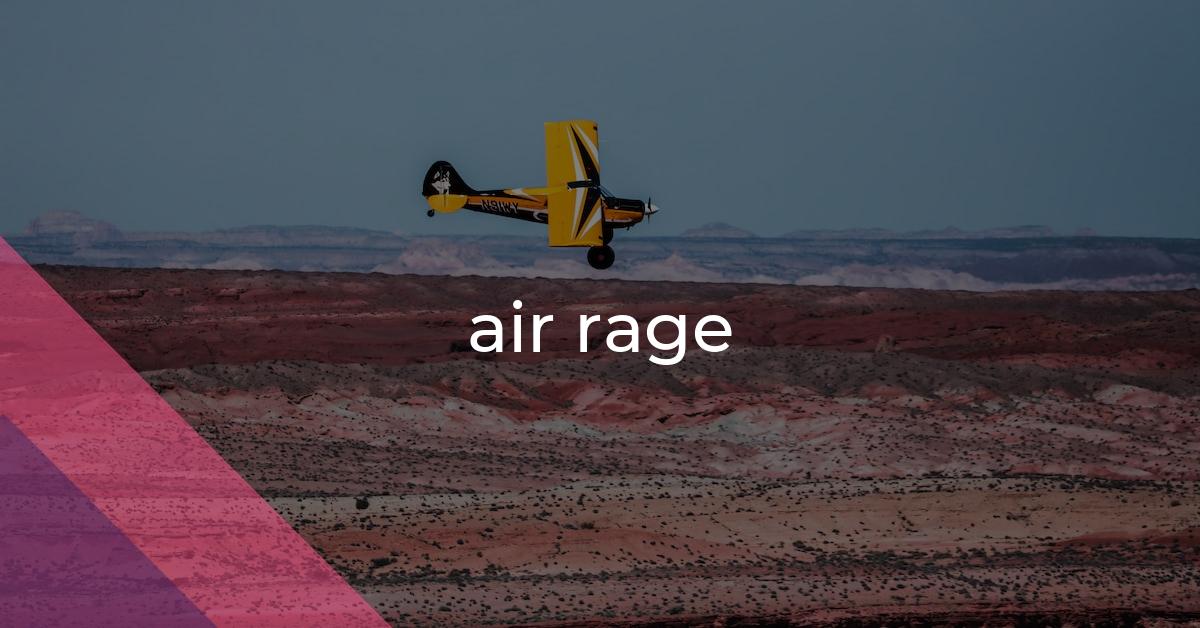air rage: Idiom Meaning and Origin
What does ‘air rage’ mean?
Air rage refers to extreme anger or aggressive behavior exhibited by airline passengers during a flight, often resulting from factors like flight delays, cramped seating, or other frustrations associated with air travel.

Idiom Explorer
A person with a short temper easily becomes angry or loses patience. They are prone to react impulsively and aggressively when provoked or frustrated.
The idiom "jet-setting" refers to the lifestyle of frequent travel, especially by wealthy or influential individuals. It conveys an image of glamour, adventure, and a fast-paced lifestyle.
The idiom "jet set" refers to a group of wealthy and fashionable people who frequently travel by jet to glamorous destinations. This term is often used to describe a luxurious and extravagant lifestyle associated with socializing in high-class circles.
The idiom "in high dudgeon" means to be in a state of extreme anger or resentment.
An idiom used to describe someone who is in an emotional or mental state of extreme agitation, distress, or confusion.
The idiom "I choose violence" is a figurative expression that conveys a willingness to engage in aggressive or confrontational behavior, often in response to a challenging or frustrating situation. It signifies a decision to forgo peaceful or diplomatic solutions and opt for a more forceful approach.
The idiom "hit the roof" means to become very angry or furious about something.
This idiom means to throw a fit of anger or frustration by displaying disruptive and uncontrollable behavior, often characterized by yelling, screaming, crying, or stomping one's feet.
The idiom "have a fit" means to become extremely angry, upset, or emotional about something.
Fiery Transformation
Air rage is a term used to describe passengers who behave badly while on board an airplane. It is a phenomenon that has become increasingly common in recent years, and it can have serious consequences for both the individuals involved and the other passengers and flight crew. The term "air rage" emerged in the 1990s, as incidents of disruptive behavior on airplanes started to attract media attention.
The increase in air rage incidents has coincided with the growth of the aviation industry. As air travel has become more affordable and accessible, more people from diverse backgrounds have started flying. This has led to an increase in instances of disruptive behavior on airplanes. There are many reasons why individuals may engage in air rage, including intoxication, frustration with delays or service, mental health issues, stress, and anxiety. The confined space, long hours, and potentially tense atmosphere inside an airplane can exacerbate these underlying factors.
One of the earliest reported instances of air rage occurred in 1985. A passenger on a commercial flight disrupted the flight by smoking in the lavatory and assaulting other passengers. This incident was the catalyst for the increased attention and concern surrounding air rage. Since then, the number of air rage incidents has continued to rise, prompting airlines and aviation authorities to implement stricter guidelines and regulations to combat such behavior.
Air rage incidents can have serious consequences. Depending on the severity of the incident, legal actions can be taken against the offenders. They may face criminal charges, fines, or imprisonment. These consequences highlight the importance of addressing the issue and finding ways to prevent air rage from occurring in the first place.
Efforts to prevent air rage have included raising awareness about the consequences of disruptive behavior on airplanes. Passengers are educated about the potential legal and personal ramifications of engaging in air rage. Flight crews are also trained to handle such situations effectively and ensure the safety and well-being of all passengers on board.
Airlines also play a role in preventing air rage. They have been known to refuse boarding or remove passengers who display signs of potential air rage. This proactive approach aims to prevent disruptive behavior before it escalates and ensures the safety and comfort of all passengers on board.
Air rage is a serious problem that can pose threats to the safety and well-being of individuals on board an aircraft. The consequences of such behavior can be severe, both legally and personally. While efforts have been made to address this problem, further exploration and understanding are necessary to effectively mitigate the occurrence of air rage.
The idioms "short temper," "canary fit," "in high dudgeon," "adrenaline rush," and "in a right state" are all related to the concept of air rage. These idioms describe different aspects of anger, frustration, and emotional outbursts. For example, someone with a short temper is easily provoked and may react aggressively or impulsively. Similarly, someone having a canary fit is experiencing extreme anger or a tantrum. Being in high dudgeon means to be in a state of intense anger or outrage. An adrenaline rush refers to the surge of energy and excitement that can accompany a high-stress situation, such as those that may be present during an air rage incident. Lastly, being in a right state describes someone who is in a highly agitated or upset state.
These idioms, along with air rage, all describe different manifestations of anger and disruptive behavior. They help to provide a deeper understanding of the emotions and reactions that can be associated with air rage incidents. By recognizing and addressing these emotions and reactions, it may be possible to better prevent and mitigate the occurrence of air rage.
Example usage
Examples of how the idiom *air rage* can be used in a sentence:
- After a long delay and multiple flight cancellations, some passengers may experience air rage and become aggressive towards airline staff.
- The news reported an incident of air rage on a recent flight where a passenger became violent and had to be restrained by the cabin crew.
- During a heated argument over reclining seats, a passenger threatened another with air rage, causing tension to escalate on the plane.
More "Travel" idioms



